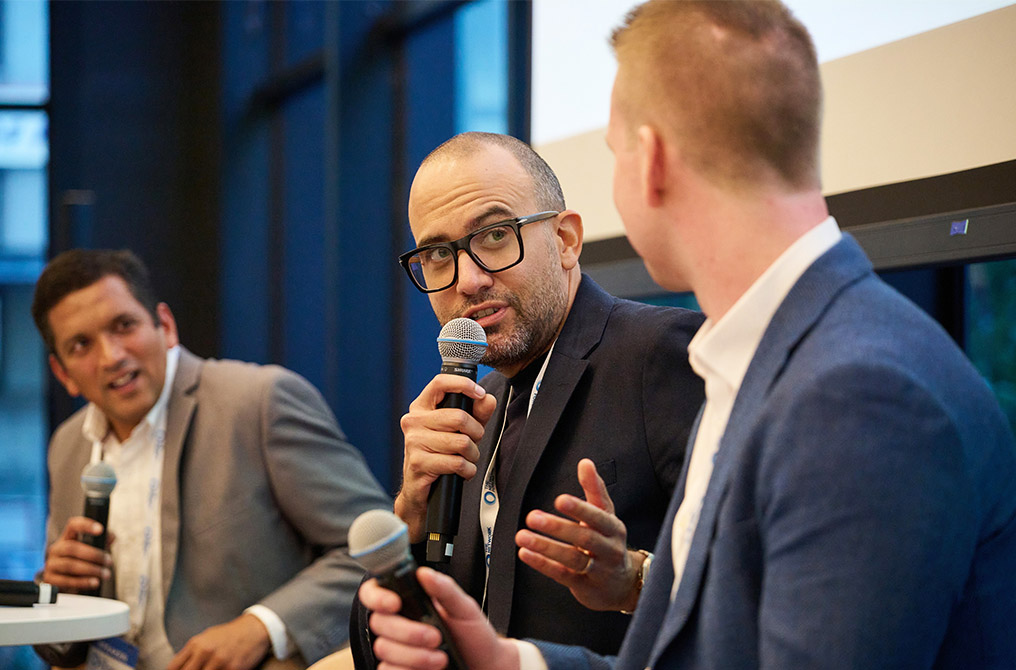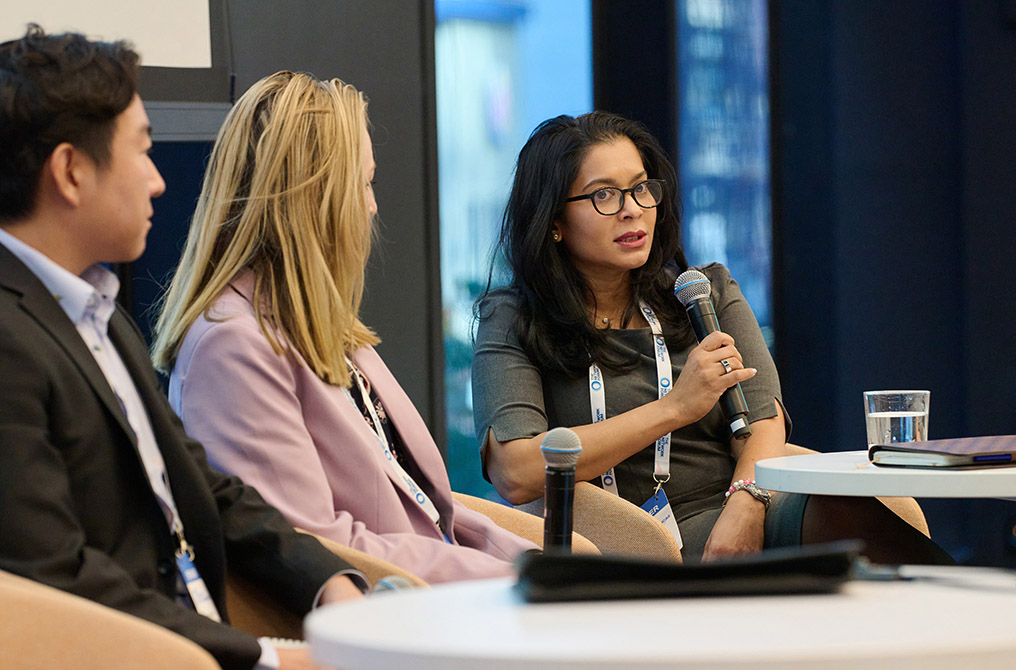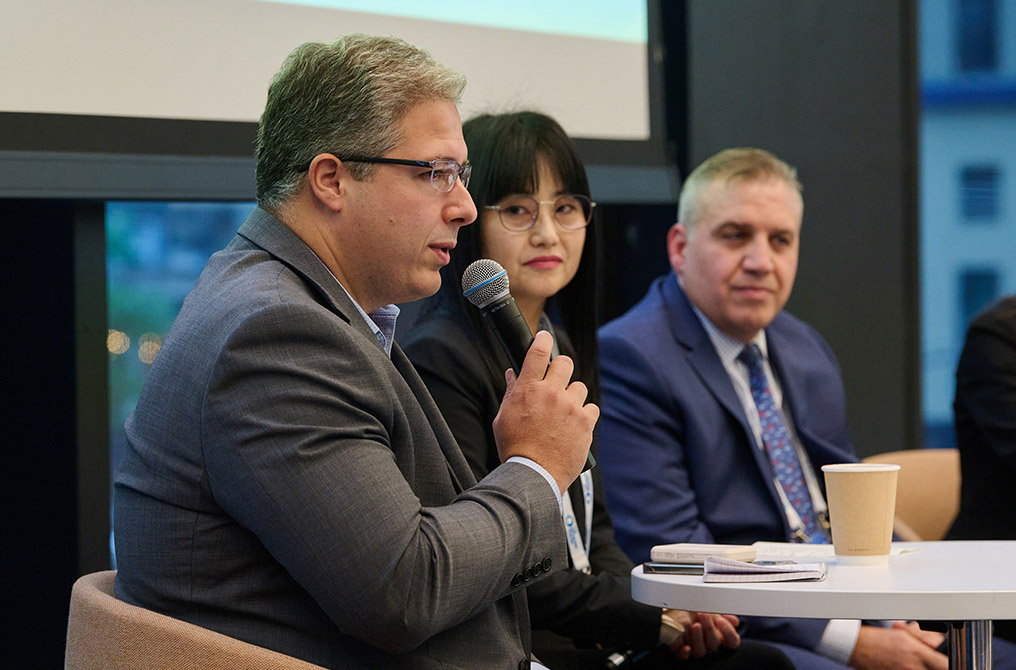4 December 2023
Transformation of the network management operating model, a turbulent external environment, settlement compression and an update on market developments in Brazil were just some of the themes to emerge at this year’s Network Forum (TNF) Americas Meeting. flow shares some of the conversations
MINUTES min read
Following on from TNF Americas in 2022, this high point in the securities services calendar reconvened in Wall Street, New York on 19 October 2023. The delegates comprised more than 100 industry experts from leading custodians, buy-side firms, technology companies, international and local financial market infrastructures (FMIs).
Arjun Kapur, from GeoQuant set the economic and political scene with the opening presentation, Geopolitical outlook and impacts on the banking industry. Unsurprisingly the looming 2024 elections were highlighted and the US’s resemblance to an emerging market (EM) noted. “The election exacerbates EM-ification of the US. Governance and social risks continue to climb through 2024 election cycle – a typical EM pattern we also saw in 2020 and 2016,” he said. The link between (higher) governance risk and (declining) investor confidence in ‘full faith and credit’ of US government is growing, he added.

Arjun Kapur, from GeoQuant sets the geopolitical scene in the run-up to 2024
New network management operating model
Covid and the emergence of new risks (i.e. geopolitical tensions, cyber threats, etc.) have transformed how network managers carry out their oversight responsibilities, highlighted experts on a panel titled Network managers in focus: Re-evaluating the importance of monitoring and managed risk and governance of agent banks and third party providers. What are the recent lessons learned? This featured network management leaders from Brown Brothers Harriman (BBH), J.P. Morgan, State Street and U.S Bank.
“Traditionally” (i.e. pre-Covid), custodians might reflect, ‘there are 100 markets in our network, so we need to get to those 100 markets as often as possible.’ It was very much a tick the box exercise, as network managers would often find themselves spending an equal amount of time in a frontier market where they had little to no assets as they would in an emerging market, where the risks are more real. The pandemic gave us a chance to stop and think about this approach,” said one network manager panelist.
Increasingly, network managers are prioritising higher-risk markets when conducting on-sight visits. With budgets being badly squeezed and banks trying to reduce their CO2 footprints, some network managers have been told to cut back on travel entirely, forcing them to be more selective about the markets they visit. “We are spending more time, effort and money going to markets where there is greater risk, complexity and higher trading volumes. For example, a network manager may visit India four times a year but might not visit a smaller emerging market at all,” added the speaker.
Initial due diligences and ongoing monitoring of local providers have both also become more efficient after the pandemic. A network manager told TNF that their team was leveraging Zoom and Teams ahead of on-site visits to talk with agent banks and local FMIs about high level issues facing the domestic market, including matters such as the state of the economy or geopolitics. “By doing this work ahead of time, we can focus on the more granular and critical challenges during our on-sight visits,” they reflected.
Although asset safety remains the underlying priority for network managers, teams are spending more time tackling issues such as geopolitical risk, cybersecurity, and business continuity planning (BCP), the audience heard. “When I started in network management 15 years ago, BCP was perhaps a 30-minute discussion, cyber-security was not even on our radars, and geopolitical risks were covered by other people in the bank. Network managers must stay ahead of these emerging risks,” said one panellist.
Post-trade’s digital reality
Digitalisation, including the emergence of digital assets and artificial intelligence (AI), were both discussed at length during TNF Americas, and have become a firm pillar of the post-trade event agenda.
“Moving from issuance [of tokenised assets] to the secondary markets will be key”
If digital assets, such as security tokens or central bank digital currencies (CBDCs) are to become more mainstream, the industry needs to move away from just talking about issuing digital assets, and instead focus on stimulating secondary market activity, said Jonathan Ehrenfeld, Head of Securities Strategy at Swift, speaking on a panel titled “Collaboration in the spotlight: Digital assets & Regulations for custody – how to get them all aligned and how far has adoption come now?” alongside Vinod Jain, Strategic Advisor, Capital Markets at Datos Insights , and Kevin Breitenother, Sales Director, Americas, at Metaco.

Collaboration in the spotlight: Digital assets & Regulations for custody – how to get them all aligned and how far has adoption come now? Panelists from left to right: Vinod Jain, Datos Insights; Jonathan Ehrenfeld, Swift; and Kevin Breitenother, Metaco
“Issuing tokenised assets is easy, irrespective of the nature of the underlying asset. Moving from issuance to the secondary markets will be key, and that will depend on things like regulation which is not yet ready. You also need different chains to communicate with each other as you may have assets on one chain that need to be exchanged with assets on another chain. Most mechanisms today supporting interoperability between chains are very insecure and are prone to hacks,” said Swift’s Ehrenfeld.
For digital assets and DLT adoption to grow, collaboration will be essential, a point made in the paper, Advancing the Digital Asset Era, Together by Clearstream, the Depository Trust & Clearing Corporation (DTCC) and Euroclear (published September 2023).1
The industry also needs to ensure that it tokenises what the panel referred to as the ‘right’ sort of assets for liquidity to emerge. “Most of the testing and token issuances so far have involved bonds, which is the right thing to do, as people understand how the asset class works plus it also has problems with liquidity,” said Ehrenfield. However, he continued, “Tokenisation does not really move the needle when it comes to obtaining efficiencies when trading bonds. We need to focus on tokenising assets like private markets, carbon credits and syndicated loans, as tokenisation will make a difference there with settlement speed, transparency, and investor access.”
With more institutional investors trading digital assets, network managers are adapting. One expert, speaking during the “Network Manager in Focus” panel during TNF, said that while clients are not leaning on custodians to add new markets to their networks, some are asking them to develop crypto custody networks. However, the importance of working with well-regulated and well-capitalised digital asset custodians, as opposed to unregulated crypto-exchanges, was highlighted by flow during its post-event coverage of TNF Asia 2022, which also coincided with the collapse of FTX.
AI: Another hype cycle or the real deal?
Appetite for all things AI is surging. In the flow article, “AI in motion: Tracking the smart money’s journey”, a proprietary dbDIG survey found 41% of Americans are familiar with ChatGPT, and a further 60% had reported its adoption in their workplaces. The post-trade world is taking note of AI, as the audience discovered during the panel entitled Where might cloud, AI and emerging tech play a role in agent banks and securities services activities? featuring Barnaby Nelson, CEO of The ValueExchange, Sanjeev Dheer, Founder and CEO at CENTRL Inc, Michael McGovern, Head of Investor Services, Fin-tech offerings at BBH, along with Ankeet Dedhia, Industry Principal, Capital Markets Specialist at AWS.
An audience poll during TNF found 29% of respondents are leveraging AI in more than 10 use cases, while a further 14% are using it in more than one but fewer than 10 use cases. A further 21% of attendees said they are either researching or testing AI. However, 29% admitted they are doing nothing with AI.
Dheer highlighted that Large Language Model (LLM) tools such as those offered by OpenAI and other companies can facilitate major efficiencies during due diligences, as it will allow network managers to reduce the amount of time spent conducting manual reviews on documents such as due diligence questionnaires (DDQs). Others, however, warn that that these technologies are prone to hallucinations, which can result in errors. While true for LLMs combing through vast tranches of publicly available data, the risks can be reduced if firms provide the tools with high quality input data, and only deploy them for a narrowly defined set of use cases. Over time, AI tools will likely become another workflow resource for network teams.
“There is a huge market of untapped talent as the industry evolves”
Diversity and inclusion in post-trade
Companies demonstrating diversity and inclusion (D&I) often outperform businesses where D&I is to be found wanting. For example, McKinsey data shows that organisations in the top quartile for gender diversity on executive teams are 25% more likely to have above average profitability than companies in the fourth quartile.2 The study found that businesses in the top quartile for ethnic and cultural diversity outperformed those in the fourth quartile by 36%.3 These drivers apply to the custody industry – a theme that was reiterated in the panel, Focusing on the S in ESG: how skillsets are evolving for the next generation of banking professionals.

Focusing on the S in ESG: how skillsets are evolving for the next generation of banking professionals. Panelists from left to right: Anthony Zheng (TD Securities); Stefanie Coleman (EY): Kamalita Abdool (Deutsche Bank)
One critical step to achieving this is for banks need to widen their talent recruitment pool, said Kamalita Abdool, Head of Securities Services, Americas, at Deutsche Bank, who was joined on the panel by Stefanie Coleman, Partner, Workforce Advisory at EY and Anthony Zheng, Director, Financial Institutions Network Management at TD Securities. “There is a huge market of untapped talent comprised of individuals who may not be identified through our traditional recruiting sources, With the evolution of custody the industry need to invest more into recruiting, developing and retaining talent across multiple levels in order to grow a sustainable pipeline of diverse talent,” said Abdool.
As baby-boomers increasingly retire and more Generation Z’ers, (those aged between 11–26), enter the workforce, banks will have to demonstrate their D&I credentials, if they are to attract the best young talent. “Generation Z is the most diverse generation to enter the workforce, and they want to work with people which reflect their communities and are not homogenous,” commented Coleman.
Banks also need to provide generation Z’ers with a sense of purpose and empowerment. Zheng said TD Securities is letting junior employees have a bigger say in decision-making by, for example, giving them a seat at the table during the intern selection process. However, there was a suggestion from one TNF audience member that some Generation Z’ers, having been forced into isolation because of lockdown during their formative high school and university years, appear to be struggling in the workplace, especially when it comes to speaking up during meetings or collaborating with colleagues.
Abdool agreed some new entrants are finding it hard to adapt to a post-Covid workplace but urged people to be tolerant. “All of us experienced disruption by Covid, students were impacted especially as most were studying virtually for two years. I think we need to provide an environment that promotes learning, inclusion and bring new talent along for the journey,” she said.
LATAM bounces back
Despite the ongoing political uncertainty, Latin American markets are enjoying renewed growth this year, as commodity prices continue to rise and more companies near-shore their operations to the region, as highlighted in the flow article “Latin America’s Resurgence”. As the macro conditions in the region start to normalise, institutional investors are once again scoping out return opportunities.
In order to attract inward investment, a number of LATAM markets are implementing post-trade reforms, especially around settlement compression. Together with the US and Canada, Mexico is also adopting T+1 from May 2024, partly because its equity market is highly correlated with the US. In contrast to the 2022 TNF Americas when the industry was getting to grips with the pros and cons of T+1, most of the larger firms today are either testing or at least preparing to test their systems for T+1.

Latin America in focus: Local market updates and views from the Value Chain. Panelists left to right: Jose Ometo (B3); Vivian Li (BNP Paribas); Walter Salvatori, (J.P. Morgan), Ana Giraldo, (Thomas Murray)
Some of the largest LATAM markets are watching their northern neighbours’ T+1 developments unfold with interest, but very few are making concrete commitments about transitioning. Jose Ometo, International Business Development at B3, the Brazilian stock exchange , said Brazil adopted T+2 a few years after the US’ implementation, and imagined the same thing would happen with T+1, speaking on a panel titled Latin America in focus: Local market updates and views from the Value Chain, alongside Ana Giraldo, Director, Americas and Eurasia, Thomas Murray; Walter Salvatori, Vice President for Network Management at J.P Morgan; and Vivian Li, a Network Manager at BNP Paribas.
However, one speaker participating on the Latest Market Developments in the T+1 settlement cycle: Who’s in and who’s not? panel warned that Brazil, being a beneficial owner market, could encounter problems if it decided to introduce T+1. “Brazil is simply not ready for T+1,” they continued.
Brazil has made a number of tangible improvements to its post-trade model over the last few years. In 2023, B3 launched a new platform developed entirely in the cloud for the electronic trading of fixed income assets on the secondary market, which is part of a wider modernisation programme involving Microsoft and Oracle.4 Ometo told the panel that B3 is also working with Nasdaq to revamp its CCP, together with Sweden-based Vermiculus to enhance its central securities depositary (CSD). “This will help us meet the automation requirements of our clients and provide for a more efficient market. Our Jomarket has seen tremendous growth in equities and futures, and this growth will be supported by the new platform,” said Ometo.
In the midst of change
Evolving market dynamics, digitalisation and the growing importance of D&I are reshaping custody. “The Americas has always been a bustling place for TNF Meetings. It was great to be in New York to hear the insights from everyone involved in these market changes,” said Andrew Barman, TNF Managing Director.
The Network Forum Americas Meeting 2023 was held in New York, 19 October, 2023
Note: all event images are ©The Network Forum



